| T O P I C R E V I E W |
| Wilderness Woman |
Posted - May 26 2003 : 3:40:31 PM
...where a Continental Army was Forged.
I have lived in New York State since 1978, but did not get down to see Valley Forge until June of last year (2002). Because I had two 4th great-grandfathers who were there during that horrible winter of 1777-1778, my visit there was one of the most emotionally moving experiences of my life. (For some information about what that encampment was like, you can read my essay HERE in the Weekly Update archives.)
The park is very beautiful, and much larger than I had envisioned. Prior to seeing it for myself, I couldn’t picture just how much space an army of some 11,000 men could require. You can take the self-driving tour or a tour bus; you can hike the roads and paths; you can bicycle your way around; or you can even bring your horse and ride around the park. The park is not closed in or fenced in any way. In fact, there are public roads that go right through portions of the park. Unfortunately, as far as I know, there is no camping available on the grounds.
The current visitors’ center is very nice, but in the near future will be even better. There is a movie available that tells about the Valley Forge encampment, there are many displays of artifacts, and there is a gift/souvenir/book shop. I was fortunate to find a lovely, large, water-color print of a snow scene with several of the log huts, that was on sale for $2 ! My favorite artifact on display is one of the three marquees (tents) that was used by Gen. Washington during the war. It is beautifully restored and is set up, encased in a climate-controlled glass room. The visitors’ center and the historical society’s museum will soon be merged into one large building that will be called the National Center for the American Revolution. See www.valleyforgemuseum.org I am looking forward to going back in a few years when that is completed.
The stone house that served as Gen. Washington’s headquarters is completely restored and is open to the public. As you climb the stairs to the 2nd floor, you will run your hand along the actual railing that Gen. Washington ran his hand along as he went to his bedroom.
Is there commercialism? Of course there is, but most of it is outside of the park and it is easily overlooked. Simply stay away from it and concentrate on the park and what happened there.
Below are several photos I took during my visit.
Image Insert:
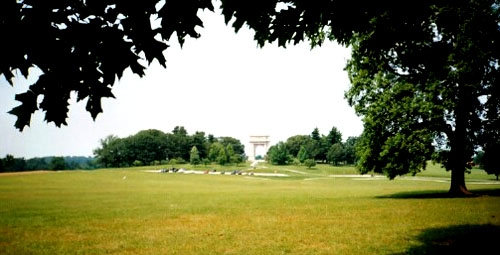
64.7 KB
Looking across a small part of the Grand Parade toward the Memorial Arch.
Image Insert:
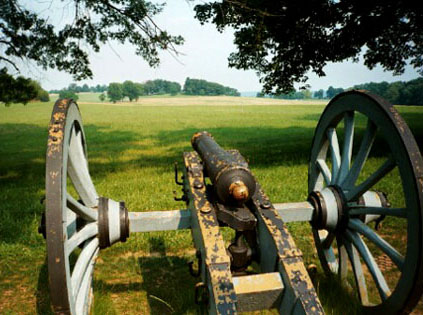
88 KB
From the area where Gen. Knox's cannon were stationed, looking across the Grand Parade toward the Memorial Arch.
Image Insert:
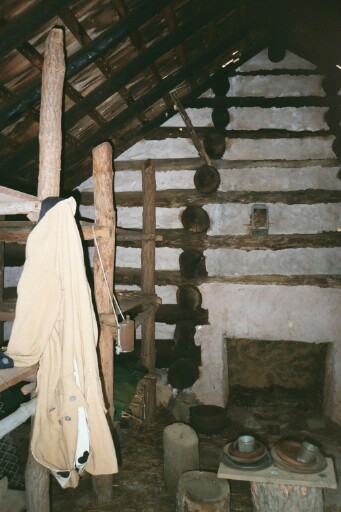
76.13 KB
Inside a replica of one of the huts that housed 12 men. |
| 12 L A T E S T R E P L I E S (Newest First) |
| ccorner |
Posted - January 06 2005 : 11:00:59 PM
This building looks alot like a Health Clinic where I work. It too has climate control as well. It was built 2 years ago but I dont know the architect. |
| Wilderness Woman |
Posted - January 06 2005 : 9:02:45 PM
Here is another article that came through on the RevWar List:
History buff to lead Valley Forge National Historical Park
By Nancy Petersen
Inquirer Staff Writer
A man who revived a moribund national monument in Upstate New York and who embraces partnerships has been named Superintendent at Valley Forge National Historical Park. Michael Caldwell, 36, superintendent at Fort Stanwix National Monument in Rome, N.Y., takes over on Jan. 23 for Arthur Stewart, who has retired after nine years.
Caldwell, a history buff with a thorough knowledge of the American Revolution, said he is looking forward to taking on the hefty challenges facing Valley Forge. "Both my personal and professional background make the challenges very intriguing," he said. "I'm there to help the park move forward." He said he believes in the power of the nation's parks to become the classrooms for the 21st century. At Fort Stanwix, site of a 1777 battle, teachers from local school districts updated all of the park's programs. "We were able to make them an integral part of the school experience," he said. "Third and fourth graders came in to learn about the American Revolution, first-graders came in to learn about colonial life, and seventh-grade math students came in to learn about engineering. Our nation's history is our civic glue. Visits to places like Fort Stanwix and Valley Forge really contribute to that civic glue."
Caldwell was also able to make the fort part of the larger community by working with area businesses and historical organizations, officials said. "Philosophically, partnerships and collaboration are where the park service needs to go in the 21st century," he said. "We've got to look at innovative ways to meet our mission."
Caldwell arrives at Valley Forge at a time when two major projects at the park appear mired in bureaucratic limbo. One is the general management plan, a document that will guide the park's management and development for the next 20 years. Launched amid great fanfare in 2002, it was scheduled to be finished last spring, but officials have yet to release a draft of the plan. National Park Service planner and program manager Dierdre Gibson said she hoped to have something ready for public review this spring.
The other project is an ambitious public-private partnership between the park and the Valley Forge Historical Society to build the American Revolution Center, a $100-million museum that will be the only one in the nation devoted to telling the entire story of the Revolution. Park service officials in Washington called a halt to that project the day before the Oneida Indian Nation was due to donate $10 million during an elaborate tribal ceremony at Valley Forge last August.
The incident embarrassed officials at the American Revolution Center, angered the Oneidas, and left the park service looking foolish. The park service blamed the fiasco on Congress, saying that the Interior subcommittee of the House Appropriations Committee had ordered a review of all partnership projects whose costs exceeded $5 million, and that fund-raising be halted until that review was complete.
Designed by Robert A.M. Stern, the museum is expected to be a major engine in the region's heritage tourism industry, attracting 700,000 more visitors to the region annually, generating 855 jobs, and adding $48.5 million to the region's economy, officials said. So far, Pennsylvania has committed $20 million to the project and Montgomery County $2.5 million.
Tom Daly, president and chief executive officer of the American Revolution Center, said Caldwell appears to be the right man at the right time. "He has a reputation within the park service of being someone who is thoughtful and considerate, reaches out to the community and has that can-do attitude," Daly said. "I am truly enthused about his coming in."
After meeting last week with the center's Board of Scholars, which includes historians |
| Scott Bubar |
Posted - February 28 2004 : 3:28:33 PM
You can add me to the list. It could use at the least more of a nod to the period, and the scale is too large.
But at least they managed to hide most of it. |
| richfed |
Posted - February 26 2004 : 05:34:55 AM
Not sure about the design - though I'm inclined to agree with Grenouille - I'll wait till I see it to pass final judgement. And, see it I shall ... and you, too, Joyce! |
| Grenouille |
Posted - February 25 2004 : 10:27:42 PM
It is a unique architectural design, but I would have rather seen something in a colonial style. I mean, isn't Valley Forge an 18th century site? I think colonial style architecture would fit into the landscape better than a 21st century anachronism. |
| Wilderness Woman |
Posted - February 25 2004 : 7:13:22 PM
Well now that you mention it... it is a bit similar to Wright's work. And perhaps that is why I find myself drawn to it. I am a fan of his work and the Prairie school of architecture, as well as of his later designs. Fallingwater... lovely! |
| CT•Ranger |
Posted - February 25 2004 : 5:15:47 PM
Looks like their architect is a F. L. Wright fanatic. Wright has his place, and I'm sure architects will be copying him for many more years, but I'm not so sure he fits here. It could be worse. |
| Wilderness Woman |
Posted - February 25 2004 : 1:28:54 PM
Here we go. Just found these. According to the video report, the building will be placed into the side of an old quarry (there is a parking lot there now), and much of it will be underground. I think this is very cool. Yes, it is quite modernistic and I usually don't care for that, but for some reason I like this. It looks to the future, while explaining the past. What do youse-all think?
Image Insert:
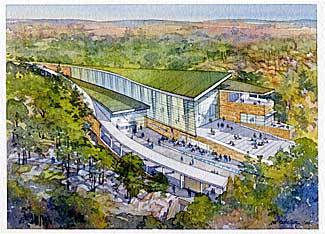
29 KB
Image Insert:
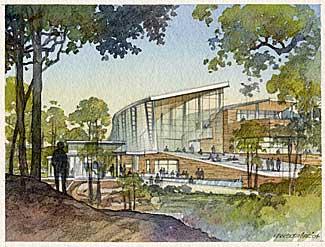
28.42 KB
Image Insert:
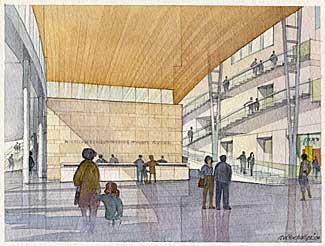
23.1 KB |
| Wilderness Woman |
Posted - February 25 2004 : 1:03:21 PM
Rich, it's getting closer!! A friend who lives near Philly emailed me this morning to tell me that a local TV station ran coverage yesterday on the official unveiling of the architect's plans for the National Center for the American Revolution. So I looked up the TV stations and found the report.
Go here... Plans Unveiled ...to read the text, and click on the video link to see a video of the report. You can see enough of the design to give you a little idea of what it will look like.
This is getting more and more exciting! Whoopee! 
BTW, Scott... per our discussion in the other thread (with the essay) in the link above, notice that this report states that "thousands" of artifacts will be on display. This is sounding very good. |
| Wilderness Woman |
Posted - October 17 2003 : 1:14:30 PM
quote:
Originally posted by richfed
Hey, WW ... maybe I'll meet you there!
You're on!
 |
| richfed |
Posted - October 17 2003 : 1:07:16 PM
Hey, WW ... maybe I'll meet you there! What a difference between what's going on here compared to the current Williamsburg situation ... uplifting, to say the least.
I have a photo of that tent which I took during my most recent trip - though it was a dozen years ago - I remember thinking that exact thought, "If it could talk ..."
Washington ... the single most "he was everywhere" Founding Father. His story exemplifies "destiny." From Jumonville to the first Presidency of the United States. Amazing. Dodged more than a few flying bits of lead over that span. |
| Wilderness Woman |
Posted - October 17 2003 : 08:58:02 AM
One of the most important items in the collection at Valley Forge is George Washington's sleeping marquee. When I was there, I was able to see the tent, which is in remarkably good condition given its age and its journey, in its climate-controlled, all-glass display room. It was an incredibly moving experience for me as I stood there gazing at an item that can truly claim: "Washington Slept Here."
I was so pleased to see this article, which is the most informative I have seen to date regarding both the marquee and the soon-to-be-built National Center for the American Revolution. I am so excited about this, and I plan to be at Valley Forge on July 4, 2006. Read on...
Washington's Tent Restoration Begins
By Larry Lewis
The Philadelphia Inquirer
October 2003
George Washington's Revolutionary War aides would have wasted no time pulling the general's grand, billowing tent from its poles and clearing out when the British were near. The tent - used for sleeping and meetings - would have been hastily folded, packed into its dark-leather valise with the six straps and buckles, and carted to the next battlefield.
Preservation experts wearing white gloves were in no hurry yesterday as they gingerly dismantled the priceless artifact at Valley Forge National Historical Park. "This is so rare," said Loreen Finkelstein, a textile conservator from Williamsburg, Va., looking at the tent in its glass exhibit case. "We're lucky it has survived at all." She will spend the next three years evaluating and restoring the tent that was Washington's battlefield headquarters, where he conversed with the Marquis de Lafayette, Alexander Hamilton, and the Comte de Rochambeau.
The tent is expected to return to Valley Forge as the centerpiece exhibit when a new $100 million National Center for the American Revolution opens in the park on July 4, 2006.
The tent is one of three shelters made for Washington by Philadelphia merchant Plunket Fleeson in 1775. The general's dining tent is in the Smithsonian, and a bigger one, believed to have stored baggage, is on display at the national park in Yorktown, Va., where the war ended. Historians said Washington lived in the sleeping tent for his first five days at the Valley Forge encampment in December 1777, before taking a local house as his headquarters.
Twelve thousand Continental Army soldiers spent that winter in Valley Forge, denuding the countryside of trees to build the log huts that were their only shelter. One in 10 died of disease. But they left the following June a much more disciplined fighting force, military historians said, to continue the struggle for independence.
Herman O. Benninghoff II, 72, a Revolutionary War historian and collector from Cinnaminson, said the 18th-century tent survived because of the tenacity of the Rev. W. Herbert Burk, an Episcopal minister from Norristown who tracked it down and bought it in 1909. Burk also founded the Valley Forge Historical Society, which is helping to build the national center.
The tent went to Martha Washington after her husband died, historians said, then to a grandson, George Washington Parke Curtis, and eventually to his daughter, Mary Curtis Lee, who married Civil War Confederate Gen. Robert E. Lee. The tent - along with all of Lee's belongings - was confiscated by the government in Washington, then returned to the Lee family by President William McKinley. In 1909, Gen. Lee's daughter, Mary Lee, sold the tent to Burk.
Benninghoff said Burk tracked Lee all over Europe to secure the sale. "He wrote letter after letter. The correspondence has survived," he said. Eventually, Lee agreed to sell the tent to Burk for $5,000 if he paid the money to a society for confederate widows in Richmond, Va.
Burk went to a Washington warehouse to retrieve what he had bought, not knowing the size of it. The tent, Valley Forge experts said, is 21 feet long, 18 feet wide, and slopes from 12 fe |
|

![The Mohican Board! [Bumppo's Redux!] The Mohican Board! [Bumppo's Redux!]](images/wwwboard.gif)







